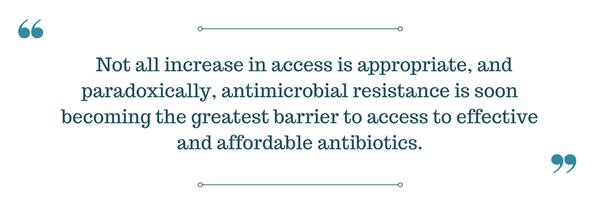Expert Spotlight: 5 Questions with Ramanan Laxminarayan
A fantastic perk of our work? Working with leading researchers around the world! One such researcher is Ramanan Laxminarayan, founder and director of the Center for Disease Dynamics, Economics & Policy (CDDEP). CDDEP engages in independent, multidisciplinary research in North America, Africa and Asia and is experienced in addressing local and global aspects of global challenges, such as antibiotic resistance. In late March, CDDEP and its colleagues published a new paper in Proceedings of the National Academy of Science (PNAS), Global increase and geographic convergence in antibiotic consumption between 2000 and 2015, that highlights how global consumption of antibiotics is skyrocketing, further driving antibiotic resistance. We interviewed Dr. Laxminarayan to get his take on their latest report and what the world can do to tackle antibiotic resistance.
1. Can you tell our readers a little bit about you, your interest in antibiotic resistance and how the Center for Disease Dynamics, Economics & Policy came to be?
I became interested in the topic of antibiotic resistance as a graduate student when I thought about how to reframe this problem as one of sharing a common resource, much like fish or the earth’s ozone layer.
CDDEP came into being as an independent organization in 2010 as a global health think-tank, bringing the best academic research to finding actionable policy solutions in the health space. CDDEP focuses on a small number of issues that we can impact deeply. These include disease control priorities, antimicrobial resistance (AMR), malaria and economic returns on early childhood nutrition and vaccination.
2. This is a milestone paper in that it charts global antibiotic use and no global body is currently collecting antibiotic consumption data. You pulled data from more than 70 countries over a 16-year time period - that’s significant! How did this research come about?
CDDEP has been tracking antibiotic consumption for a while and in 2014 we published a paper in Lancet Infectious Diseases that estimated global consumption based on large scale datasets for the first time. At that time we didn’t have the data to be able to assess 15-year trends or to calculate defined daily doses, so we were happy to be able to do it for the paper published by PNAS.
3. This increase in antibiotic consumption has been considered “good” because it means increased access to these life-saving medicines in low-and middle-income countries, but also “bad” because it could mean more inappropriate use. Can you explain?
In many low- and middle-income countries, more people die because of lack of access to antibiotics than do because of resistance. Therefore, increasing access to antibiotics is surely a good thing.
However, not all increase in access is appropriate, and paradoxically, antimicrobial resistance is soon becoming the greatest barrier to access to effective and affordable antibiotics.
4. What are some effective strategies or interventions the U.S. and countries around the world can take to improve antibiotic stewardship and reduce antibiotic use?
There are many but the key point here is that the priority for action has to be country specific. For instance, China would do well to focus on hospitals’ incentives to sell antibiotics as a way of generating revenue. In India, the unregulated sale of irrational fixed dose combinations is the greatest threat. And in the United States, the significant level of community use of antibiotics because of doctors’ overprescribing of drugs should be the primary focus for action.
5. CDDEP is leading a Global Antibiotic Resistance Partnership to develop actionable policy proposals for India, Kenya, South Africa, and Vietnam. Can you tell us more about the partnership and its end goal?
When we launched GARP in 2009, there was little awareness about AMR in these countries outside the community of microbiologists and infectious disease clinicians. We wanted to do three things. First, broaden the community to include nurses, veterinarians, regulators, pharmacists and others with a direct interest and influence on the AMR problem by convening national working groups of eminent experts in each of these domains. Second, to publish situation analyses for each country to quantify the scale of the problem and contributing factors that were both AMR specific and AMR sensitive. Third, to build the political momentum for national action to address AMR. All of this was initiated before the World Health Assembly passed the Global Action Plan. GARP helped prepare the ground for acceptance of this plan by sensitizing countries to the AMR problem.
6. And a bonus question! Between this latest report, “The State of the World’s Antibiotics”, the animated “Superbug Story: The Diary of Staph”, and the weekly digests, CDDEP produces a lot of interesting content. What’s next?!
We care deeply about communicating our research and sometimes this takes the form of reports, our ResistanceMap website or animated videos. Our next State of the World’s Antibiotics report will be out in the next three months. Stay tuned! (Editor's note: Thanks for the heads up -- we can't wait to read it!)




